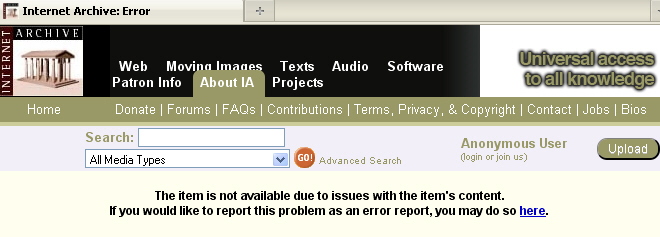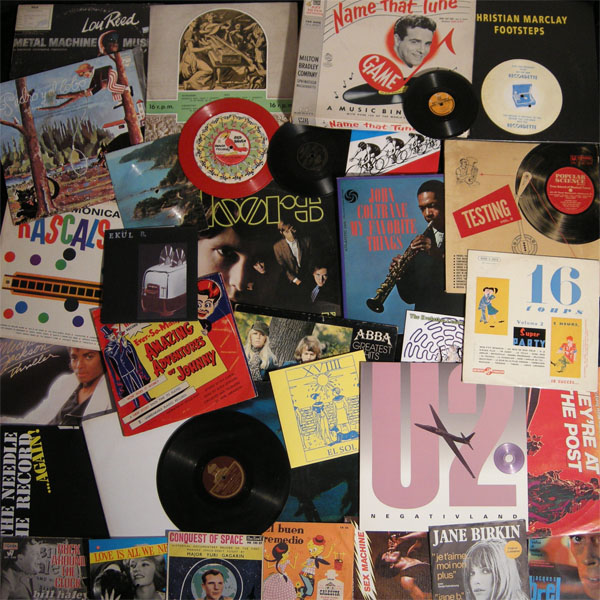censura de "this is the end, beautiful friend"
A finales de septiembre de 2010, el disco "This Is The End, Beautiful Friend", de File Under Toner, fue descolgado (técnicamente "hecho inaccesible") del Internet Archive por "problemas con el contenido" y reemplazado por el siguiente mensaje:
http://www.archive.org/details/hr061
El Internet Archive es una organización sin ánimo de lucro destinada a la preservación de historiales Web y recursos multimedia, que tiene como lema "Acceso universal a todo el conocimiento". Dentro de su sección "Netlabels" está alojada (entre otras 1500) Hazard Records, desde junio de 2004. En ese momento, conscientes de que algunas referencias del sello podían tener contenidos delicados, y sin ningún deseo de poner en un compromiso a una institución como el Internet Archive, les avisamos de que una de las líneas de trabajo del sello es la apropiación. El Internet Archive dio su aquiescencia implícita a albergar obras basadas en la apropiación.En agosto de 2008, Hazard Records editó el disco "This Is The End, Beautiful Friend", de File Under Toner (seudónimo de Anki Toner para algunos proyectos) y lo albergó en el Internet Archive, como había hecho con las 60 referencias anteriores de su catálogo. El disco ha estado alojado más de dos años en el Internet Archive sin ningún problema. Este disco, como todos los de Hazard Records, es de Dominio Público.
El disco "This Is The End, Beautiful Friend" ha sido grabado a partir de los últimos surcos (supuestamente silenciosos) de una selección de discos (analógicos, se entiende), que se reprodujeron en un tocadiscos de velocidad variable, y sobre las cuales se aplicaron reverberaciones, ecos y retardos (delay). El resultado audible es pues, básicamente, el ruido de superficie de la aguja del tocadiscos frotando el vinilo.
La selección de los discos utilizados como material de partida se basó en tres o cuatro criterios. El disco toca temas como el turntablismo, los clicks & cuts, el silencio, la indeterminación, la originalidad, la autoría, el apropiacionismo, la propiedad intelectual, la historia de la tecnología de reproducción musical, el coleccionismo de discos, los discos conceptuales, el fetichismo, la gramofonía...
Un primer criterio fue el formato: se usaron mayormente discos de vinilo, pero también algunos de pizarra, cartón, y algunos otros materiales menos habituales, para conseguir una mayor variedad de sonido.
Otro criterio importante fue el sentimental, y se usaron discos que tienen una carga emocional importante para el autor, discos que escuchaba en su infancia, algunos de sus discos favoritos....
Un último criterio, sin embargo, fue "político". El disco plantea las preguntas "¿tiene copyright el último surco de un disco de vinilo?" y "si lo tiene, ¿a quién pertenece?". Para ello utiliza discos de artistas que han protagonizado episodios de censura con anterioridad. En este caso se han utilizado surcos de discos de Abba, Michael Jackson y James Brown, tres entidades famosas, entre otras cosas, por haber llevado a juicio a otros artistas que han utilizado fragmentos de su obra fuera de su contexto original. También se ha utilizado el último surco de una de las escasas copias supervivientes del disco "U2" de Negativland, disco de cual se tuvo que destruir toda la edición (incluidos los máinclusters) a raíz de una denuncia.
Naturalmente, todo ello no tendría ningún sentido si no se explicara detalladamente en los créditos la procedencia de cada surco silencioso utilizado.
En los tiempos que corren, esto conlleva sus riesgos. Según la ley estadounidense (y hay que recordar que los servidores del Internet Archive están en los EEUU) un proveedor de servicios de Internet no es responsable del contenido que cuelgan los usuarios en sus servidores si desconoce que el material infringe la ley. Pero en el momento en que se le notifica una posible infracción debe actuar inmediatamente si no quiere convertirse en cómplice de la misma. Por ello, no es necesaria una orden judicial, sino una simple petición de parte interesada, para retirar contenidos de Internet.
El Internet Archive, sobre todo en su sección Community Audio, se arriesga a que los usuarios cuelguen (de hecho, lo hacen) material claramente protegido por copyright y, lo que es peor, muy alejado de los motivos por los que se creó el Internet Archive. Entendemos pues que se vean obligados a descolgar algunos archivos. Probablemente tengan que dedicar a ello bastante más tiempo del que quisieran.
Sin embargo, lo más descorazonador de este caso es que desde que el disco ha sido descolgado del Internet Archive, este no ha respondido a ninguna de nuestras solicitudes de aclaración, incluida la siguiente carta abierta:
http://www.archive.org/post/326909/this-is-the-end-beautiful-friend-made-unavailable-at-the-internet-archive
Esto es extraño porque el nuestra experiencia con el Internet Archive es que siempre contestan a cualquier pregunta o solicitud de ayuda de índole técnica en un plazo muy razonable. Extraño y preocupante.Sin embargo, en Hazard Records creemos que todo esto es un sinsentido fruto de la presión a que está siendo sometido cualquier intento, como el del Internet Archive, por ampliar las fronteras de la cultura libre de derechos. La batalla está siendo cruenta porque a día de hoy discutir el copyright (o siquiera no reclamar el copyright a que se pudiera tener derecho) representa atacar la base misma del capitalismo.
Por ello, hemos decidido asumir que el disco ha sido descolgado por error después de ser detectado por algún robot o procedimiento automatizado de detección de infracciones al copyright. No creemos que el Internet Archive tenga interés en librarse de este tipo de trabajos, más bien al contrario, aunque probablemente estén atados de pies y manos ante situaciones como éstas.
En consecuencia, hemos des-censurado (hecho nuevamente accesible) el disco en octubre de 2010. Por no cargar las tintas, hemos sustituido parte de los créditos del disco por una explicación de lo que ha ocurrido, y hemos dejado los créditos originales como un fichero de texto, que se puede descargar junto con el disco (pero que esperamos sea invisible para los rastradores automáticos). Esperamos que con ello solucionemos esta situación. Sin embargo, tal vez sea una buena idea descargar el disco pronto, por si acaso.
El disco se encuentra aquí: http://www.archive.org/details/hr061b
-------------------------------------------------------------------------------------------------------------------------
CREDITOS DEL DISCO QUE SUPUESTAMENTE HAN CAUSADO EL PROBLEMA:
---------------------------------------------------------------------------------------------------------------------------
recording the silent final grooves of records. not so silent after all. playing them loud enough to capture the hiss, the pops, the clicks. adding a couple of digital delays, some EQ and filtering, a little reverb here and there… not much, really. it’s all in the records if you know where to listen.
of course it is difficult to listen to these grooves with automatic return turntables (stupid consumer-oriented machines). maybe that’s why you never paid attention.
you will probably have to raise the volume to play this album, which will add a little electronic hum, different with every equipment on which you play it. this is a (nice) feature, not a bug.
if you have the means, stamp these tracks on a three sided LP. you will have three free extra end grooves, and a blank side to needle-surf.
one last thing. probably some people will think this is not legal, i should not be allowed to do this, i am stealing somebody else’s copyrights (john cage’s?), etc...
nevermind, most people will just think this is not music.
SIDE A
THE BEGINNING, ACTUALLY The Doors “The Doors” (Elektra, 33 rpm, side B, 500-71SB1). This is the end, beautiful friend, of The Doors first album. And it is the beginning of mine, which is not the first, anyway (but is the last so far –at the time of writing this-, of course). What a coincidence.
FAVORITES John Coltrane “My Favorite Things” (Atlantic, 33 rpm, side A, ST A 60303 D). Well, yes, let’s admit it, these are some of my favorite records. That’s why I chose them.
AND WHO GIVES A SHIT Negativland “U2 – 1991 A Cappella Mix” (SST, 45 rpm, side A, SST272A). As you all know, this record does not exist. All copies were destroyed after Island/Warner sued Negativland. Everyone who had received a copy of the record -reviewers, record stores, radio stations, etc.- was notified to return it. (If they failed to comply, they might be subject to penalties which might include imprisonment and fines). Once returned, the records were forwarded to Island for destruction. Nevertheless, this track has been recorded from one of the remaining copies of the original 1991 SST edition. Thanks, Vicenc and Esther!
SPEEDMETAL MACHINE MUSIC Lou Reed “Metal Machine Music” (RCA, played at 78 rpm, side A, CPL-2-1101-A-1). Not the non-silent locked groove at the end of side four, of course, but the supposedly silent locked groove at the end of side one.
LET ME DIE IN YOUR FOOTSTEPS Christian Marclay “Footsteps” (Rec Rec Music, 45 rpm, 26A-LC7981). Christian is one of the guys who taught us how to listen to records. When I got this record, it was SO dirty I did not dare to play it for a while, afraid it might damage my precious equipment. It probably did, and probably that was what it needed.
SURF ACE NOISE The Beach Boys “Surf’s Up” (CBS,33 rpm, side B, S CRB 32085 / CBS 31774B2). This is one of these records that is better every time you listen to it. The final groove is better every time too.
THRILLERPHONICS Michael Jackson “Thriller” (EPIC /CBS, 33 rpm, side A, 85930A). Free samples, blank tape is derivative, nothing of itself, the commerce of noise, chimeras of sound, starting from scratch, the medium is magnetic, aural wilderness, the buzzing of a titanic bumblebee.
MAGIC The Magic Record Album (Atlantic Records, 78 rpm, parallel grooves, side A, 114-A) Double 10-inch record with parallel grooves. It plays a different story each time, in total 256 different stories! You don’t need to wait for the final groove to get some randomness, but you can still do. It depends on what you are looking for.
HIGH FIDELITY Popular Science Monthly “Testing Vol. 2” (Urania, 33 rpm, side A, UPS-2B). This 1957 LP is subtitled “True Sound Of Musical Tones” and is supposed to “prove your system’s true high-fidelity”. By the way, the Urania label made some of the best cover art ever.
PARTY v.a. “16 Tours Super Party vol. 2” (Ducretet Thompson, 16 rpm, side A, 620V003A). I always wondered what was the use of the “16 rpm” position in a record player until Anton Ignorant gave me this record. If I remember well I gave him a Spanish-Russian dictionnary in exchange.
ORGY Orquesta Salvador “Orgie” (Odeonette, 6 inch shellac disc, played at 115 rpm, side A, 30003a). Older records are usually referred to as “78s”, but they were recorded at any speed between 70 and 100 rpm. For this Orgie I chose 115rpm, which is as fast as I could spin.
SEX MACHINE James Brown “(Get Up I Feel Like Being A) Sex Machine” (Polydor, 45 rpm, side A, 2001071A) We all know what the late great J.B. tought of people who sampled him: he sued them. And probably there is someone who still does. It is interesting to note that, since the complete Sex Machine track spans over the two sides of this single, what I recorded (end of side A) is actually in the middle of the song.
SIDE B
JUSTIFIED Abba “Greatest Hits” (EPIC, 33 rpm, side A, SEPC69218A). This one is absolutely justified, isn’t it?
MOI NON PLUS Jane Birkin & Serge Gainsbourg “Je t’aime… moi non plus” (Golden 12, 45 rpm, side A, G12/88A). A masterpiece too frequently mistaken for a novelty record. Years ago we used the piano part in a song. Later I used part of the lyrics in another. Why should’t I use the final silent groove now? By the way, this is the german edition of the single.
FAHR FAR FUN Kraftwerk “Tour de France” (EMI, 45rpm, side A, 1C006 1652047A). The end of side A of the 45 rpm french edition of the single. But this is the side with the german lyrics, as you probably guessed.
NAME THAT TUNE Name That Tune Game (Milton Bradley Co.,33 rpm, side A, TV26965-1A). This game is a music bingo. One player is the “disk jockey” and plays the record randomly. The other players receive a card each with song names and have to guess the tunes. The first player to complete a row (five tunes) on his card wins the game. I guess they never guess this one.
HOWLIN’ WOLF Serge Prokofiev “Pedro y el lobo” (Philips, 33 rpm, side B, P13168 2L). This record belonged to my parents. I liked it when I was a kid, but I find the drawing of the wolf so scary I could not even look at it. Sometimes I am still scared if I hear the Peter And The Wolf tune unexpectedly.
SARDANA Cobla Catalana. El Sartiró de la Cardina (Fonoscope sound postcard, 45 rpm, c43-M287). Cardboard record postcard sent by my mother to her parents and sister on july 12, 1960. It promises “200 perfect auditions”. This is the 199th.
HARMONICA The Harmonica Rascals “The Harmonica Rascals” (International Award Series, 33 rpm, side B, AKS-177B). Harmonica is the only instrument I can play, so I included a harmonica record. They also crackle.
VIOLINS Mendelsohn/Tchaikowsky “Concert(s) for Violin and Orchestra” (Club Internacional del Disco, 16 rpm, side A, CID-301614-A-1) Another 16 rpm record. I was missing some classical music in this collection.
FLY ME TO THE MOON Conquest Of Space (BriTone, 45 rpm, side A, MK100EP/BM7453). This is a historical documentary record of the first manned space-orbit flight by Major Yuri Gagarin, a 1961 british edition of the USSR recording. The original sound recording has so many crackles, and the actual record is so used (by my parents on a merciless 60s portable player) that I could have recorded any part of the record with the same effect.
HELLO DOLLY Doll Record no-25 (Jesmar, 115 rpm, parallel grooves) This 2-inch doll record was a present from Ajo. It is so small that I had to buid a special adapter to be able to play it. And it should have played a little faster (maybe around 120) but I could not spin that fast.
ROCK AROUND THE CLICK Bill Haley and the Comets “Rock Around The Clock” (Warner Bros, 45 rpm, side A, WV5102/45.5102.A). I could simply not resist the pun. Sorry.
LA VALSE À MILLE ECHOS Jacques Brel “La valse à mille temps” (Philips, 33 rpm, side B, AA 432371 2E). Brel is incredible. Let’s waltz to a thousand echoes.
SIDE C
AGAIN Criminal Element Orchestra “Put The Needle On The Record… Again!” (BCM Records, 45 rpm, side B, DM-C0397B). It would rather be “don’t take the needle out of the record” but it’s ok if you put it back.
TYPEWRITING La Garde Républiquaine de Paris. “La Nouba - Marche Afriquaine” (Gramophone and Typewriter Ltd. And Sister Companies, 78 rpm, 30009X) This one sided shellac disc is the oldest record in this collection (probably dating from around 1905). In it, the French “Garde Républiquaine” band is trying to play an african rhythm. They miss the spot, at least from a XXIst century point of view, but they play a strangely relaxed repetitive rhythm which turns out to be quite beautiful.
SI LOS CURAS Marcos Redondo con banda y coro. “Himno de Riego” (Odeon, 80+ rpm, side A, 184238A). El Himno de Riego has been the national anthem of Spain during the Trienio Liberal and the First and Second Spanish Republics. It was banned during the Franco regime and we used to sing it clandestinely.
HORSES “They’re At The Post” (Homestead Records, parallel grooves, 33rpm, 1011). This is a phonofinish” game record. Eight parallel grooves play a horse race with the same start and eight different ends. You are supposed to bet on the outcome. But my bet is that the record has just one end (er… I mean one on each side; this is the end of side one)
TAKE ME TO THE MOVIES Red Raven Orchestra “The Little Red Engine” (Red Raven Movie Records, 78 rpm, side B, M-2). Red Raven Movie Records are special children's records with a 16-frame animation printed right onto the disc. When played using a phenakistoscope placed atop the phonograph spindle, they display a moving cartoon.
LOOK MA NO HANDS unknown artist (home recording on a self recordable Recordio Disc, 78 rpm). You never know what you can find in these old recordio discs, from a time when people recorded their own records at home (at least, some people did).
(NOT) ONLY A BEATLE SONG The Hollywood Star Orchestra “Love Is All You Need” (Prestodisc, 33 rpm, cardboard record). Nice australian cardboard record, nice picture, nice song (not the Beatles’), nice final noisy groove.
GREYISH The Beatles “The Beatles (White Album)” (EMI/Odeon, 33 rpm, side A, album 4.297.514, side 162-04173-A). Now it’s them! We are having white, black and a lot of shades of grey records these days. By the way, when did they stop numbering the white albums?
PINK REMEDY Trio Las Pulguitas “El buen remedio” (Discos Calesita, 78 rpm, side B, CA24B). Argentinian label Calesita released a series of colored kiddies records, and they are the most beatufil colored records I have ever seen. This one is fleshy pink.
EGO Macroelvis Supermassa “XVIII El Sol” (G3G, 45 rpm). I figured I should use one of my own records too. Maybe I can sue myself if I need to. By the way, this is a limited numbered edition. I used the end of side B of number 61/497. Which makes a great difference.
BONUS TRACK Ekül B. “Musique Plastique” (Beta-Lactam Ring Records, lathe cut, copy 32/50) We are not playing a silent groove but the real thing on this one.
WHIP ME, CHRISTY (PARTS I, II & III) Evolution Control Committee “The Whipped Cream Mixes” (Pickled Egg, 45 rpm, side A, AH14331A). Grand finale: I allowed myself a little improvising with my fingers on the turntable on this one.


